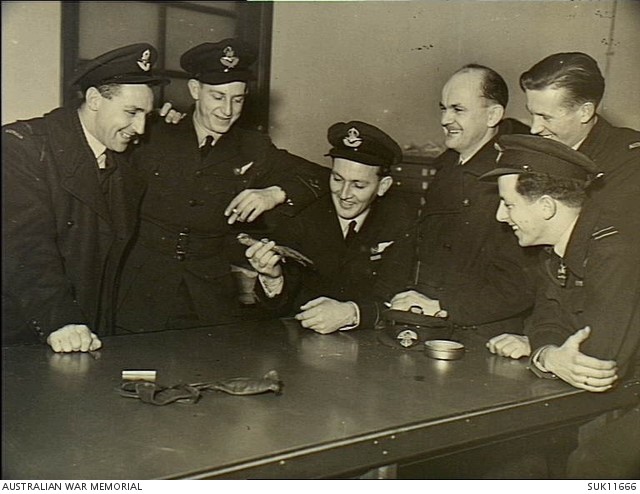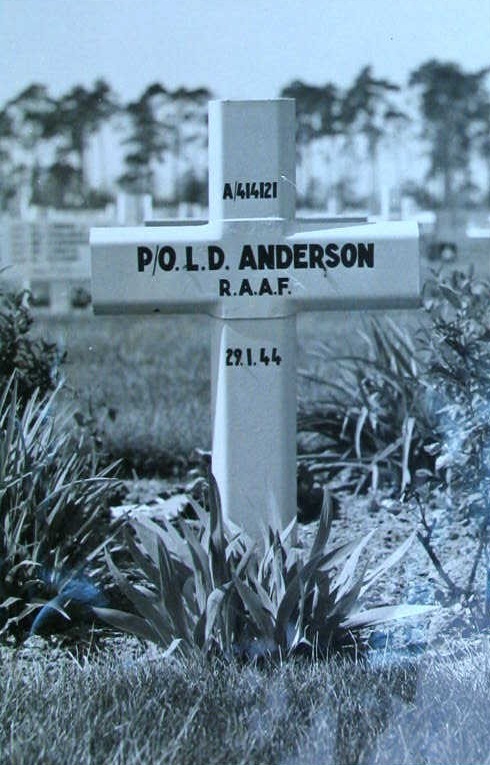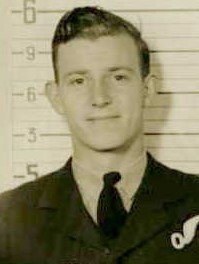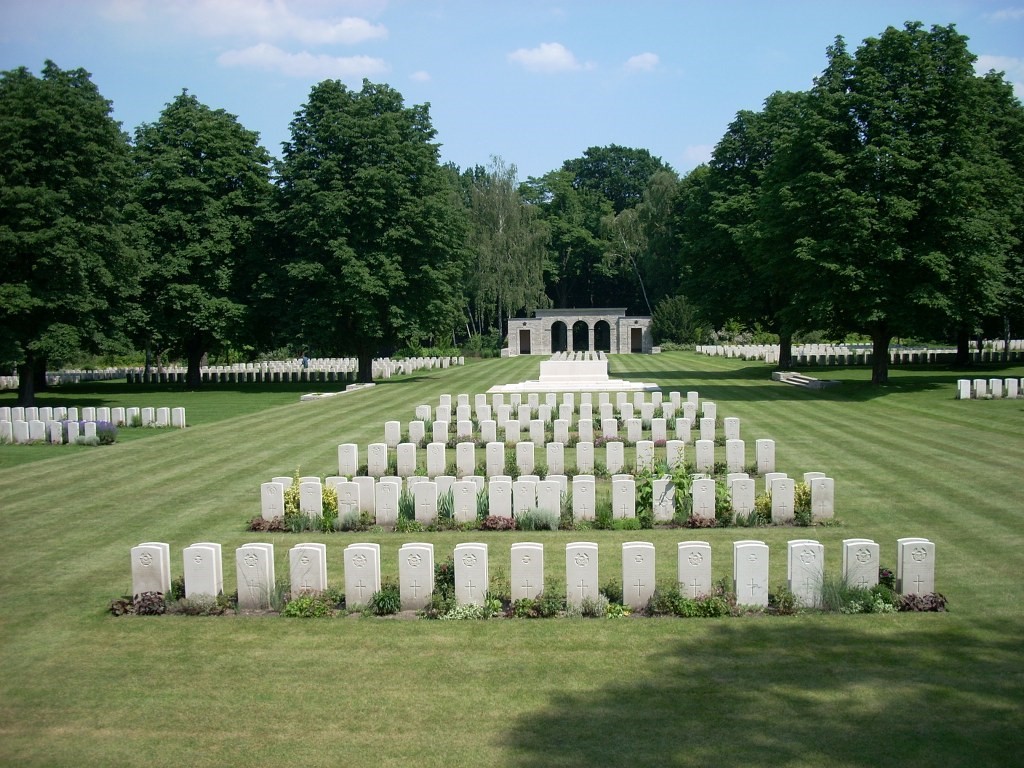Pilot Officer Leslie Dean Anderson, the son of Leslie John Anderson and Florence Anderson (nee Greenbury), was born at Toowoomba in Queensland on 26th February 1923. He was educated at the Toowoomba Grammar School. After leaving school he was employed as a Clerk at Toomaroo Pty Ltd in Toowoomba. At the age of 18 years and 5 months he was enlisted into the Citizen Air Force of the R.A.A.F. on 16th August 1941 at No. 3 Recruiting Centre in Brisbane 1941 after giving a commitment that he would serve for the duration of the war and an additional twelve months. His physical description at the time of enlistment was that he was 5 feet 11 inches in height and weighed 133 pounds. He had a fair complexion, brown eyes and light brown hair. He stated that he was of the Presbyterian religion. He gave his next of kin as his father, residing at 198 Stuart Street in Toowoomba. His father later changed his address to 4 Drayton Road in Toowoomba.
Pilot Officer Leslie Anderson joined No. 3 Initial Training School at Sandgate in Queensland on 16th August 1941 and he was a student on No. 20 Pilots Course. He joined No. 12 Elementary Flying Training School at Bundaberg in Queensland on 10th December 1941. He joined No. 2 Embarkation Depot at Bradfield Park in Sydney on 28th March 1942 to prepare for overseas service on attachment to the Royal Canadian Air Force. He embarked by sea transport from Sydney in New South Wales on 24th April 1942 and he disembarked in Canada on 15th May 1942. After his arrival in Canada he joined No. 3 Manning Depot at Edmonton in Alberta on 18th May 1942. He joined No. 3 Air Observer School at Regina in Saskatchewan on 24th May 1942 where he received training on basic navigation techniques. Upon completing his course he was promoted to the rank of Temporary Sergeant and awarded the Air Navigator Qualification Badge on 14th September 1942. He joined No. 1 (Y) Depot at Halifax in Nova Scotia on 25th September to prepare for transfer to England on attachment to the Royal Air Force.
After his arrival in England he joined the Personnel Despatch & Reception Centre at Bournemouth on 5th November 1942. He was sent to No. 9 (Observer) Advanced Flying Unit at Royal Air Force Station Penrhos in Wales on 14th December 1942. He joined No. 20 Operational Training Unit at Royal Air Force Station Lossiemouth in Scotland on 16th February 1943 where he received training to prepare him for night bomber operations using Vickers Wellington aircraft. He was promoted to the rank of Temporary Flight Sergeant on 28th February 1943. He joined No 466 Squadron Royal Australian Air Force at Royal Air Force Station Leconfield in Yorkshire for operational duties on 12th May 1943. The squadron’s main roles were the strategic bombing over Germany and laying naval mines in the North Sea. He was appointed to the commissioned rank of Pilot Officer on 2nd September 1943. He was attached to 1658 Heavy Conversion Unit at Royal Air Force Station Ricall during the period 26th August until 10th September 1943 where he received training on Halifax bombers.
Pilot Officer Leslie Dean Anderson was Navigator and a crew member of a No. 466 Squadron Royal Australian Air Force Halifax Bomber HG 345 that was detailed to attack Berlin in Germany on the night of 28/29th January 1944. The aircraft was shot down by a German ME 210 fighter on 29th January 1944 and the aircraft crashed in a small field in the city area. His father was notified by telegram on 2nd February 1944 that he was missing on air operations.
The Commanding Officer of No. 466 Squadron wrote the following letter to his father on 31st January 1944:
Dear Mr Anderson, Prior to receiving this letter you will have received a telegram from Air Board, Melbourne, informing you that your son, Pilot Officer Leslie Dean Anderson, has been reported missing from an operational flight on 28th January 1944. It is with sincere regret that I am writing this letter to confirm this sad news, and to convey the heartfelt sympathy of all members of the Squadron to you, and to all members of Pilot Officer Anderson’s family, in your great anxiety.
On the night of 28th January 1944, the aircraft in which your son was Navigator, took off to carry out an attack on enemy territory. This flight represented one of the many courageous efforts called for from the Royal Australian Air Force in this war, and it was undertaken with efficiency and resolution, for which your son’s crew was noted in the Squadron. Unfortunately, the aircraft did not return. The most searching enquiries through all possible channels have so far revealed nothing but naturally it will take some time for possible information to reach this country from enemy sources. Meanwhile, we can only hope that Pilot Officer Anderson and the other members of his crew are prisoners of war. If any further news should come through, you will be notified immediately. Yours sincerely, Group Captain.
Subsequent advice from the International Red Cross Committee in Geneva, based on German reports, confirmed that two of the crew members survived and were captured by the Germans. Subsequent information from German sources confirmed that Leslie Anderson had lost his life. At the time of his death Leslie Anderson was 20 years of age.
The Air Ministry in London received notification by German Totenliste (Death List) No. 210 that Pilot Leslie Dean Anderson had lost his life on 29th January 1944.
Pilot Officer Last, one of the survivors, whilst in captivity on 15th December 1944 provided the following information:
Our aircraft went out of control. The Captain gave the order to abandon. I was the first to leave. Pilot Officer Anderson was standing beside me when I left the aircraft. I have since learned from Pilot Officer Coombes the Captain, who was last to leave at a low altitude, that everyone in the front of the aircraft had gone when he left. He was in some doubt as to the fate of Pilot Officer Trotman. The inter-communication was out of action and he could not find out whether he had left or not. Pilot Trotman was uninjured and had plenty of time to do so. I regret I have no further information regarding the fate of either Pilot Officer Anderson or of Pilot Officer Trotman.
The other surviving crew member Sergeant N.D. Hughes provided the following report:
Pilot Officer Leslie Dean Anderson abandoned the aircraft shortly before I did and I saw his parachute open. Since then I have heard nothing whatsoever with regard to his welfare. When we abandoned the aircraft he was uninjured.

Australian War Memorial photograph SUK11666
Group portrait of crew members of No. 466 Squadron. Leslie Dean Anderson is believed to be second from the left.
In 1949, the Missing Research and Enquiry Section exhumed several bodies in the German Cemetery at Elsgrund/Doberlitz near Berlin and Leslie Anderson’s body was identified by the initials “L.D.A.” on the khaki shirt he was wearing. His remains were laid to rest in the Berlin 1939-1945 War Cemetery. A photograph of the temporary cross placed over his grave is contained in his archive file.
His photograph and the following details of his death were published in the Toowoomba Chronicle on 11th May 1944:
Mr and Mrs L.J. Anderson, of Ruthven Street, Toowoomba, have been officially notified that their only son, Pilot Officer Leslie Dean Anderson, previously reported as missing as a result of air operations on the night of January 28, is now reported to have lost his life. The official intimation set out that a report received from the International Red Cross at Geneva, stated that, according to German information, Pilot Officer Anderson lost his life. Pilot Officer Anderson was one of a crew of a Halifax bomber which took part in an attack on Berlin on the night of January 28, from which he did not return. He had taken part in eighteen operational flights, and this was the second occasion on which he had taken part in the bombing of the German capital. He gained his wings in Canada and had two years’ service with the Air Force overseas. Pilot Officer Anderson, a former Toowoomba Grammar School boy, was twenty years of age.

Leslie Anderson’s grave in the Berlin Cemetery prior to its official layout and placing of Commonwealth War Graves Headstones on each grave.
Additional information:
Pilot Officer Leslie Anderson was killed during the 13th bombing raid during the “Battle of Berlin”. Alan W. Cooper’s book, “Bombers over Berlin – The R.A.F. Offensive November 1943 – March 1944”, is an excellent detailed history of the bombing of Berlin. It lists all of the aircraft lost and details of each aircraft’s crew and whether they were killed or became prisoners of war. I consider it essential reading to fully appreciate what the bomber crews faced when attacking this formidable target.




